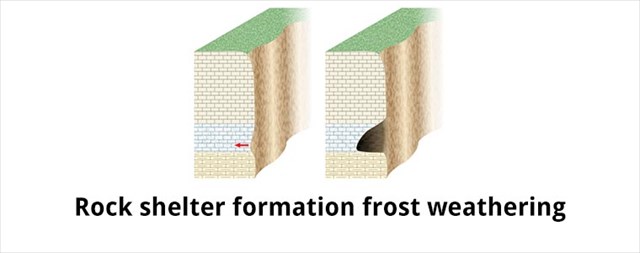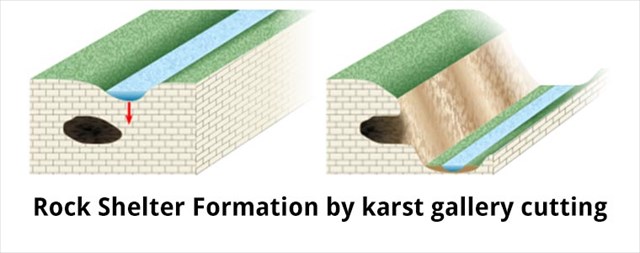Arkansas provides many great opportunities to explore nature, as the "Natural State" you will not want to forget your camera, a walking stick, and a buddy or two to go out and enjoy nature.
If you have been working on the Earth Caches on these trails you may have learned what erosion is and the different forms of erosion. On this Earth Cache Adventure we are going to learn about Crepuscular Caves aka: rock shelters.
After completing this Earth Cache you will have a better understanding of:
- What Rock Shelters are
- Primary formations of Rock Shelters
- how each rock shelter formation is made
- the use of early habitat dwelling of rock shelters
So what is a rock shelter? A rock shelter (also known as a rock-house, crepuscular cave, or abri) is a shallow cave-like opening at the base of a bluff or cliff. There are three types of formations, but lets first learn how this phenomenon happens.
Formation
Rock shelters form because a rock stratum such as sandstone that is resistant to erosion and weathering has formed a cliff or bluff, but a softer stratum, more subject to erosion and weathering (limestone), lies just below the resistant stratum, and thus undercuts the cliff.
The three primary formations are:
- Frost Weathering
- Karst
- River Erosion
Lets take a closer look at these three formations.

Frost weathering is a collective term for several mechanical weathering processes induced by stresses created by the freezing of water into ice. The term serves as an umbrella term for a variety of processes such as frost shattering, frost wedging and cryofracturing. The process may act on a wide range of spatial and temporal scales, from minutes to years and from dislodging mineral grains to fracturing boulders.
Frost weathering is mainly driven by the frequency and intensity of freeze-thaw cycles and the properties of the materials subject to weathering. It is most pronounced in high altitude and latitude areas and is especially associated with alpine, periglacial, sub-polar maritime and polar climates but occurs wherever freeze-thaw cycles are present.

Karst topography is a landscape formed from the dissolution of soluble rocks such as limestone, dolomite, and gypsum. It is characterized by underground drainage systems with sinkholes and caves. It has also been documented for weathering-resistant rocks, such as quartzite, given the right conditions. Subterranean drainage may limit surface water with few to no rivers or lakes. However, in regions where the dissolved bedrock is covered (perhaps by debris) or confined by one or more superimposed non-soluble rock strata, distinctive karst surface developments might be totally missing.

River Erosion
My Earth Caches have taught you that erosion is the action of surface processes (such as water flow or wind) that remove soil, rock, or dissolved material from one location on the Earth's crust, then transport it away to another location. They have also taught you that River Erosion can erode in four ways:
- Abrasion or corrosion - This is when large pieces of bedload material wear away the river banks and bed.
- Attrition - This is when the bed load itself is eroded when sediment particles knock against the bed or each other and break, becoming more rounded and smaller.
- Hydraulic Action - This is when the force of water erodes softer rock.
- Solution or corrosion - This is when acidic water erodes rock.
A simple shelter
A rock shelter is not at all what most people associate with a cave: a dark confined space, where sunlight does not reach. But rock shelter actually do fit the definition of a cave (see  Classification of Caves). However, rock shelters are not of speleologic interest, but they are important archaeologic excavation sites. Thats simply because they are ideal shelters for nomadic people, offering a sort of weather protection, while still allowing light and warmth to enter, especially the ones facing south. And almost as important as that, the ceiling not only protects people but also their remains, it even covers them after some time with debris from the eroding cliff face and thus conserves them for millennia. This makes rock shelters the most important archaeologic sites for prehistoric remains.
Classification of Caves). However, rock shelters are not of speleologic interest, but they are important archaeologic excavation sites. Thats simply because they are ideal shelters for nomadic people, offering a sort of weather protection, while still allowing light and warmth to enter, especially the ones facing south. And almost as important as that, the ceiling not only protects people but also their remains, it even covers them after some time with debris from the eroding cliff face and thus conserves them for millennia. This makes rock shelters the most important archaeologic sites for prehistoric remains.
Did you Know?
The most important rock shelter of the world are located in France, the abris along the Vezere valley in the Perigord. This is the place where abris were discovered for archaeologic research. Many locations are actually typesites or type locale for archaeologic eras. Famous are also the cliff dwellings of the Mesa Verde National Park in the U.S.A.. Then there are the important dwellings and cave entrances of the Lone and Blau valleys in southern Germany, where the oldest artworks of mankind were discovered.
Requirements: (please do not put your answers in the log)
Now that we learned a little bit about erosion and the effects it has on limestone, take a moment to study ground zero. With the information above, and information at GZ you should be able to answer the following questions. You have 24 hours to send me an email (found in my geocaching profile) with the correct answers. Failure to do so will result in the removal of your "Found it log". Please add the GC code and title in the subject line. If you are sending answers for multiple people in your group, please add all the names in your email to ensure they don't have their log deleted :) Photos with you/group of the area would be greatly appreciated.
1 In your own words explain what a rock shelter is.
2 According to the placard at Ground Zero what was this rock shelter used for?
3 What are the three ways a rock shelter can be formed.
4 What type of formation was likely the cause of Ground Zero
5 According to the placard at Ground Zero who were the mostly likely to use this area.